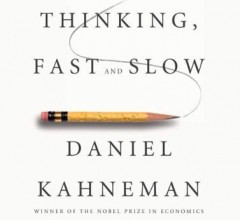Thinking, Fast and Slow
Book Review: Thinking, Fast and Slow by Daniel Kahneman
 Scientists love to divide human thinking into two parts: right brain vs. left brain, rational vs. emotional, conscious vs. subconscious, and no doubt many others. Daniel Kahneman, Nobel Prize winner in Economics, proposes a simple split to explain much of human behavior: fast vs. slow. He makes it clear that this is an artificial construct, but at the same time draws upon decades of research to demonstrate its utility.
Scientists love to divide human thinking into two parts: right brain vs. left brain, rational vs. emotional, conscious vs. subconscious, and no doubt many others. Daniel Kahneman, Nobel Prize winner in Economics, proposes a simple split to explain much of human behavior: fast vs. slow. He makes it clear that this is an artificial construct, but at the same time draws upon decades of research to demonstrate its utility.
System 1 vs. System 2
Fast thinking (dubbed System 1 by Kahneman) is unconscious, emotional, instinctive. Fast thinking results in snap judgments and, sometimes, prejudice. Slow thinking (System 2) is what most of us would consider actual thought: it’s conscious, deliberative, and mostly rational. We use both fast and slow thinking when we process information and make decisions, according to Kahneman, but we tend to avoid slow thinking when we can. Slow thinking is more work for our brain and consumes more resources. Fast thinking enables us to get through the day by handling routine decisions with minimum fuss. When we make important decisions, both systems can be engaged even though we are mainly aware of the slow thinking part.
A Deep Dive
Recent years have seen a plethora of books dissecting our sometimes irrational thinking processes – Predictably Irrational, Brain Bugs, Mistakes Were Made (but not by me), Sway, Nudge, How We Decide, The Invisible Gorilla, and others all added to the conclusion that human decision making is far less rational than we think. Indeed, my own book, Brainfluence, is mostly based on that fact. (Brainfluence focuses on practical applications, not the underlying science.)
Thinking, Fast and Slow, however, digs deeper than any of these and explores a broader range of behaviors. It’s a big book – 512 pages – and Kahneman patiently and clearly walks us though topics ranging from “rare events” to “causes trump statistics.”
The breadth and depth of Thinking, Fast and Slow, as well as the fact that much of the research described was carried out by Kahneman and his associates, add to the persuasiveness of his case. To be sure, Kahneman cites many other researchers and mentions numerous studies that will be familiar to students of this space (and a few that may not be), but he is clearly master of this material.
Insights Abound
Kahneman’s book isn’t about marketing, investing, politics, or similar topics, but it yields plenty of insights into human behavior that can guide those, and other, endeavors. A typical gem, all too often exploited in politics:
A reliable way to make people believe in falsehoods if frequent repetition, because familiarity is not easily distinguished from the truth.
Kahneman notes that even repetition of a fragment of a false statement lends credibility to it because of the concept of cognitive ease; if it’s easier for our brain to process, it’s more believable.
Kahneman knows how to turn a phrase, too. Discussing the famous “gorilla study,” he writes,
The gorilla study illustrates two important facts about our minds; we can be blind to the obvious, and we are also blind to our blindness.
The latter point is an ongoing theme of the book: not only do our powers of observation and reasoning fail us, but we rarely become aware of those failures.
Lay readers need not be put off by the size of the book and credentials of the author. I’ve never seen Kahneman lecture, but I’d guess he’s a very popular professor. His style is exceptionally clear and actually entertaining; he seasons his writing with gentle humor. Thinking, Fast and Slow is brilliant and a must-read for anyone interested in the brain, mind, thought, and decision-making. Indeed, I’m finding it is a go-to reference for many cognition topics.
Amazon Link: Thinking, Fast and Slow
Kindle Link: Thinking, Fast and Slow
